The food industry is continually evolving, particularly with the rise of cloud kitchens and food delivery apps. With this, standing out among restaurateurs or hoteliers has become more challenging than ever.
Generally, when it comes to digital marketing, restaurant owners rely heavily on social media and ads to promote their businesses and attract new customers — and for good reason. These tools are great for expanding your reach and showing the best of what your business has to offer.
However, there has been an increase in email marketing for restaurants in recent years. This communication channel has emerged as a way to capture the interest of new diners and nurture existing guests.
When done well, email marketing can be a game-changer for your restaurant. It will allow you to:
- Reach potential and existing customers with personalized content
- Build stronger customer relationships
- Promote events and specials
- And what’s the most important – have a fully booked restaurant
In this guide, we’ll explore how you can harness the power of email marketing for restaurants to help you build lasting customer relationships and increase the number of returning visitors. We’ll also show you some restaurant email examples to inspire you.
The basics of restaurant email marketing
In this section, we’ll dive deep into what restaurant marketing is all about while also highlighting why it’s a necessary marketing channel for restaurant owners.
Understanding email marketing for restaurants
Restaurant email marketing is a strategy involving email campaigns to achieve certain marketing goals. These goals could be to promote a restaurant, attract new customers, interact with clients, or even improve customer experience.
Restaurants can send various types of emails to their subscribers, depending on what the intent is. Some of the common ones are:
- Special occasion emails designed to celebrate certain milestones or holidays
- Welcome emails that introduce the restaurant and its offerings to new subscribers
- Promotional emails that promote special offers, discounts, or seasonal menus
- Survey and feedback request emails that help gather customer feedback
Below is an example of an automated birthday email sent by the restaurant. Offering a discount for the celebration is a great way to invite customers to celebrate their birthdays at the restaurant.
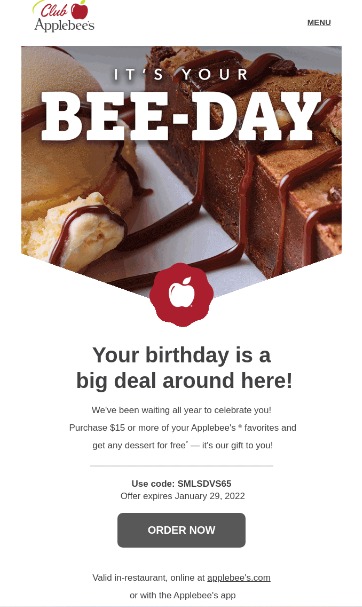
Image via Really Good Emails
The benefits of implementing restaurant email marketing include:
- Increased customer engagement: Regular emails will inform customers about your restaurant’s activities, promotions, and updates. Sharing the information that your audiences are interested in will help you engage with them effectively.
- Targeted and cost-effective marketing: Compared to other marketing channels, restaurant email marketing is highly cost-effective. As you can directly connect with audiences, you can have a targeted conversation and reap better ROI.
- Seamless communication: While staying in touch with your audience is necessary, it can be overwhelming. Email automation helps you to streamline communication. It enables you to send relevant content on time to build brand credibility and stay on top of customers’ minds.
- Attract more reservations: Reservation emails can increase bookings and ensure a steady flow of guests.
- Collect valuable feedback: Survey or review request emails help you gather feedback so you can better understand your customers’ experiences.
Building an effective restaurant email list
The foundation of any successful restaurant email marketing lies in building a high-quality list of subscribers.
However, to maintain the integrity of your email list, you must employ ethical strategies. That means you should follow laws and regulations, such as the CAN-SPAM Act and GDPR.
Below are some of the best ways to generate email leads for your email marketing activities:
- Online reservations: Ask guests for their email addresses when they make an online reservation. After confirming, give them the option to join your mailing list.
- Incentives for signups: Encourage customers to join your email list by offering incentives. These could be in the form of discounts, free appetizers, or a special gift.
- Leverage social media: Social is a great way to promote your email signup form. Use posts, stories, and ads to invite followers to subscribe to your mailing list.
- Loyalty program signup: Require guests to provide their email addresses when they want to join your restaurant’s loyalty program.
Crafting compelling content for restaurant emails
Writing engaging email marketing emails is necessary to achieve your business goals. These emails can make a huge difference in the effectiveness of your marketing strategy.
To make it easy to create compelling content for your emails, you can use AI tools provided by email marketing services for restaurants or hire a copywriter.
In this section, we’ll discuss the essential components of an effective restaurant email. We’ll also share a few examples for your inspiration.
Key components of a restaurant email
A well-crafted email should engage your audience, provide valuable information, and encourage your subscribers to take the desired action.
Let’s explore the key components that make up a successful restaurant email.
Catchy subject line
Your email content may be great. However, if subscribers don’t open your emails, your efforts become fruitless.
Here’s how you could write an irresistible and catchy subject line:
- Keep it short and clear
- Use terms like “Today Only” or “Limited offer” to create a sense of urgency
- Add a touch of personalization by using the recipient’s name, location, or even just a personal pronoun
High-quality images
First of all, if you want to look professional, only high-end visuals are allowed in your communication.
Secondly, emails that contain visual elements always have a higher engagement rate. Adding high-quality images can instantly capture your customers’ attention and encourage them to read further.
Here are various ways you can use high-quality images effectively in your emails:
- Place them at the top of your email to capture attention right away
- Use them alongside CTAs to highlight the next steps you want readers to take
- Optimize them for different screen sizes
Clear and compelling call to action (CTA)
One of the best ways to ensure a great conversion rate for your email campaigns is to have strong CTAs. They guide your guests to take the next desired step, such as booking a table or placing an order.
You can make your CTAs effective by:
- Using action-oriented language like “Book Now” or “Get 20% Off”
- Include one CTA that stands out and leads the reader to the target page
- Ensuring it’s relevant to your email’s message
Restaurant newsletter examples
A restaurant newsletter is a periodic email that a restaurant sends to its subscribers. It aims to keep recipients updated on what’s happening in the restaurant.
A good restaurant newsletter often includes a variety of content, such as:
- Special offers, coupons, or discounts on menu items
- A sneak peek at the must-try dishes, drinks, or seasonal specials
- Customer stories or testimonials
- News and updates from the world of food and beverages
Here are three restaurant email newsletters to inspire you for your next campaign.
Restaurant newsletter example 1: Upcoming event
In this newsletter, Blurb uses high-quality imagery to grab the readers’ attention right away. By highlighting the restaurant’s upcoming event and providing important details, Blurb builds excitement. This can create FOMO and compel the subscribers to book the event.
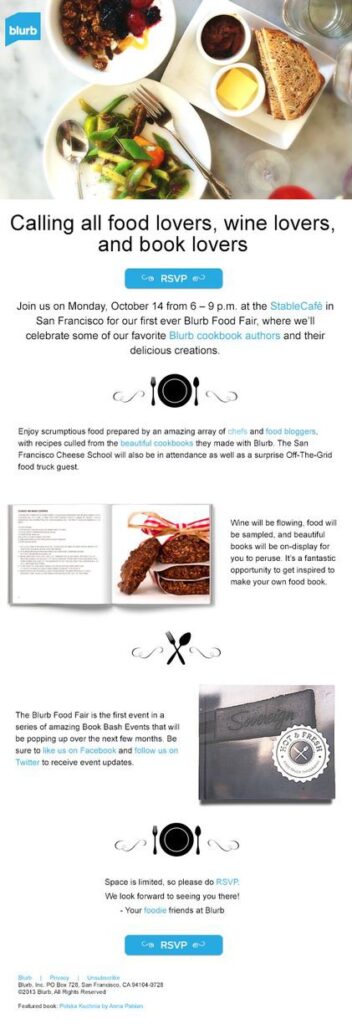
Image via Pinterest
Restaurant newsletter example 2: A captivating welcome
Yoko’s welcome email grabs the readers’ attention in an instant. The clear CTA button, written in all caps, stands out from the rest of the email and lets the reader know what action to take next.
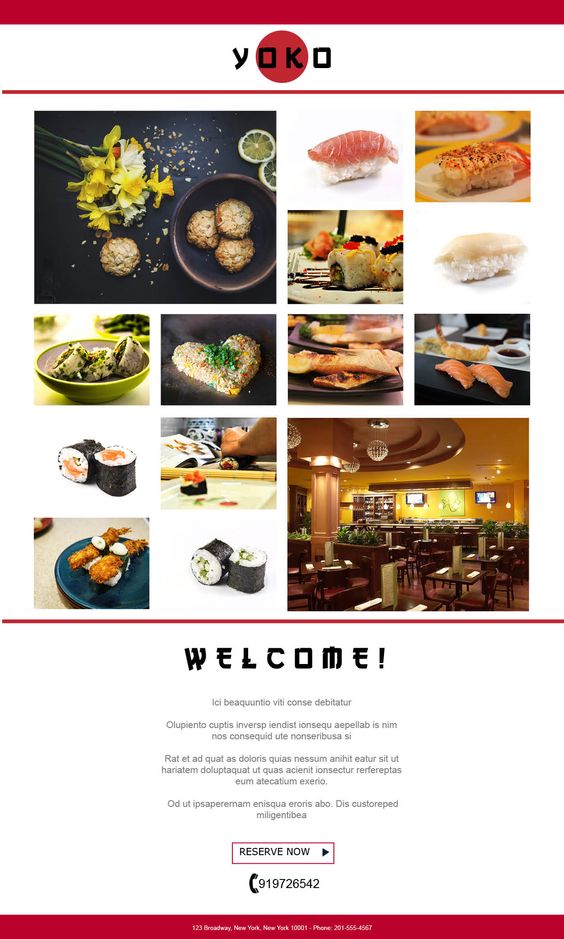
Image via Pinterest
Restaurant newsletter example 3: Special offers to entice subscribers
Everyone loves a good deal, and this email example effectively showcases huge discounts on selected meals. The discounts are written in a bigger font to make it stand out, and the captivating images effectively entice readers to act.

Image via Pinterest
Types of emails for enhancing dining experiences
Leverage the power of email marketing by sending out different types of emails. Targeted and timely communication can help you build a strong relationship with your audience.
Let’s take a look at the important types of emails you should consider.
Reservation confirmation emails
These emails reassure diners that their reservation is confirmed. They also confirm the details of the reservation to ensure guests show up on time.
A well-crafted reservation confirmation email will include the following information:
- Reservation details, including the date, time, and number of guests
- The restaurant’s address and contact information
- Special requests issued by the guest, if any
Below is an example of a reservation confirmation email. Aside from the standard details, the restaurant has mentioned a few must-try dishes to pique the customers’ curiosity.

Image via Pinterest
Welcome emails for new subscribers
These emails are often sent immediately after a new subscriber signs up for your restaurant email list. They help establish a positive first impression and set the tone for future communications.
They may also promote incentives to encourage new subscribers to make their first order or book a reservation.
Take a look at this exceptional welcome email by Goop Kitchen.

Image via Really Good Emails
Promotional emails
One of the best restaurant email marketing strategies for gathering full restaurants is sending promotional emails.
Why? Because everyone loves a great deal. Recent studies show that more than 80% of diners will try a new restaurant because they received a promotion or discount.
When it comes to promotional emails, you could:
- Offer a happy hour special
- Highlight seasonal menu items
- Provide a limited-time offer
Here’s an example of a great promotional email. It goes further by recommending other foods for those who don’t like burgers, yet still at a discounted price.
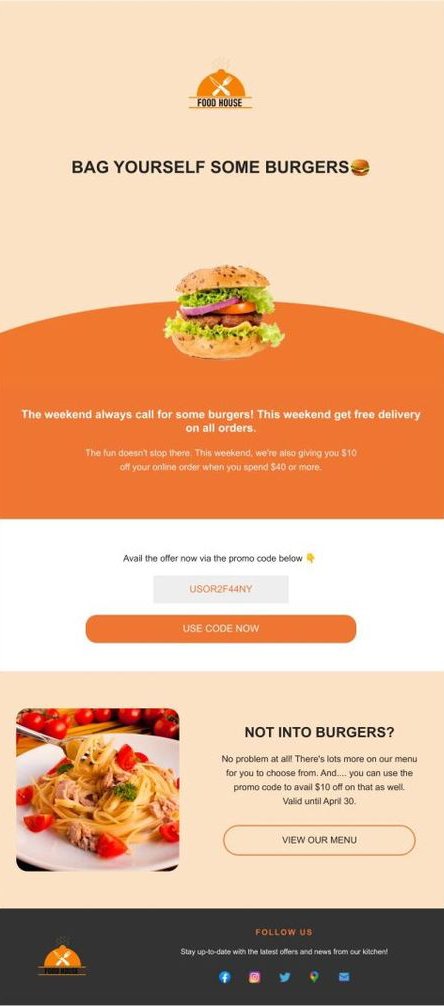
Image via Pinterest
Event and catering service emails
If you want to offer more than regular dining, you need these emails to promote your capabilities to cater to numerous events.
When drafting these emails, ensure it has the following elements:
- The type of events you can cater for
- The venue options available
- Booking and inquiry process
Below is an example of an event and catering service email. It presents various details to establish the restaurant’s credibility.
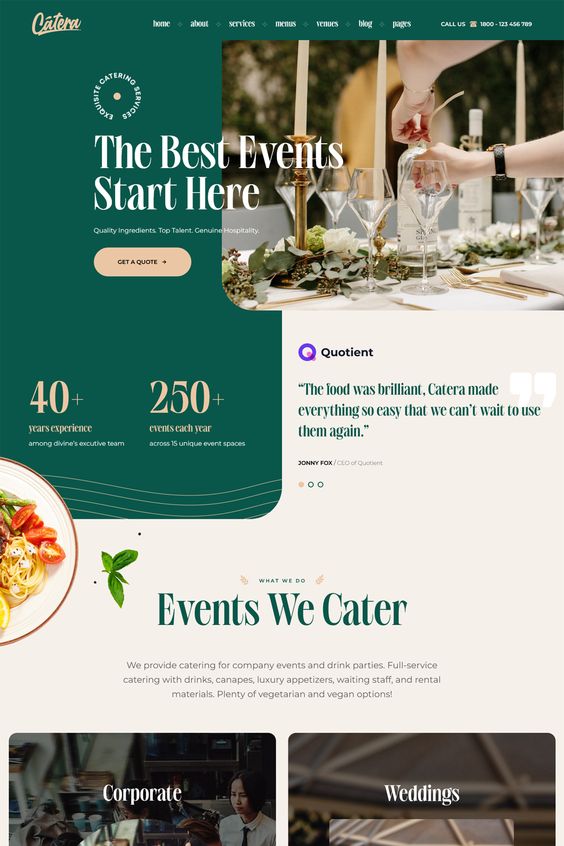
Image via Pinterest
Customer loyalty and rewards emails
These emails can help you recognize and reward your most loyal customers. Doing this fosters a deeper connection with your customers and encourages repeat visits.
They usually:
- Offer updates on loyalty program points
- Celebrate milestones like membership anniversaries
- Include rewards for successful referrals
This email by Chipotle is an example of a customer reward email. Chipotle explains the rewards program in a simple and clear language.

Image via Really Good Emails
Special occasion emails
These emails can help you connect with customers on a personal level. Think birthdays, anniversaries, holidays, and other special events.
They’re tailored to:
- Show customer appreciation
- Provide exclusive deals on special days
- Offer memorable experiences beyond just regular dining
Below is an example of a special occasion email. The brand includes a special July 4th offer and a bold CTA button that directs subscribers to make an order.

Image via Really Good Emails
Feedback and review request emails
These emails can help you create an avenue to engage with guests and show that you value their opinions.
They include but are not limited to:
- Online review requests
- Follow-up feedback
- Pre-visit and post-visit surveys
- Product or menu feedback
The image below shows an example of a feedback request email that’s simple, clear, and straight to the point.
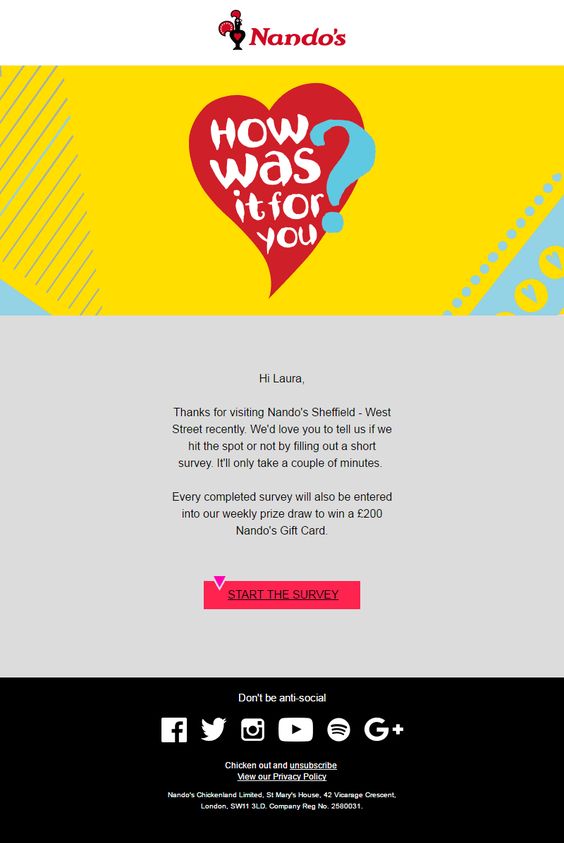
Image via Pinterest
Choosing the right email marketing software for restaurants
In this section, we’ll discuss the features you should look for in an email marketing software. We’ll also highlight our top three restaurant email marketing software recommendations.
Features to look for in an email marketing software for restaurants
The right email marketing software offers a blend of features that are tailored to meet the unique needs of the food industry.
Here are some of the features to look out for when choosing the best email marketing software:
Automation capabilities
The right email marketing software should be able to:
- Automate welcome emails, reservation reminders, and follow-up emails
- Schedule emails in advance
- Automatically send emails based on certain triggers
Integration options
Having a software that seamlessly integrates with other applications can help streamline your operations. This includes point-of-sale (POS), content management systems, and payment getaways.
Customizable templates
Choose an email marketing software with an ample supply of well-designed templates that you can customize to fit the needs of your restaurant.
It should also be able to simplify your design process even when you don’t have technical coding skills. MailerLite, for instance, features an easy-to-use drag-and-drop editor.
Three best email marketing software for restaurants
These three email marketing tools can help enhance your customer engagement and boost revenue.
Omnisend
Omnisend is an easy to use solution, offers good automation, an extended library for all kinds of email and signup form templates, and has a product review feature, in case you have an online store. This makes it ideal for restaurants looking to create personalized, effective email campaigns.
With Omnisend’s free plan, you can send up to 500 emails per month, enjoy award-winning 24/7 customer support, and use 250+ beautiful email templates. You can also create popups, send SMS reminders, and many more.
Brevo
Brevo is a great software that lets businesses run their marketing campaigns across email, SMS, and chat in one platform.
It offers a free plan that allows you to send up to 300 emails a day. This makes it ideal for small restaurants that have a limited marketing budget.
MailerLite
With its user-friendly interface and great automation features, MailerLite provides various tools to create visually appealing campaigns and track performance.
In addition, when the number of subscribers starts growing, Mailerlite is one of the most affordable solutions in the market.
Advanced tips and tactics for restaurant email marketing
While you can achieve your business goals with effective email marketing for restaurants, it’s important to know how to do it right.
Let’s discuss some of the best practices you can implement in your marketing strategy.
Personalize your message
When it comes to email marketing, personalization is a huge game-changer. It involves tailoring your email’s content to your audience’s individual preferences and behaviors. Try to adopt this approach in your case, too.
Here’s how you can personalize your restaurant email campaigns:
- Segment your subscribers based on their dining preferences, order history, and dining frequency
- Send out personalized offers and promotions on special occasions like birthdays
- Use location data to send offers and promos to customers near your location, helping you drive local engagement
- Send out personalized recommendations and new product suggestions to encourage your audience to try something new that aligns with their tastes
Implement effective call-to-action strategies
The CTA is a critical component of any email marketing campaign. A well-crafted CTA helps guide recipients towards the desired action, thereby boosting engagement and conversions. It should be clear, compelling, and placed strategically.
Here are some of the best practices to consider when creating an effective call to action:
- Use strong, action-oriented verbs that direct readers to what they need to do next; a great example is “Reserve Your Table Now”
- Make the CTA button stand out by increasing its size and using contrasting colors
- Add only one call to action for every email to enhance focus and drive better results
- Ensure that your call to action is direct and unambiguous so the recipient can easily understand what the next step is
Here’s a great example of a restaurant marketing email with a well-crafted call to action. Both CTAs have bold, contrasting colors and are written in caps to make them stand out.
They’re also strategically placed, one at the top and another at the bottom. This type of placement ensures that subscribers won’t miss the CTA even when they’re just skimming through the email.

Image via Pinterest
Test and optimize your restaurant’s email campaigns
Regular testing and optimization is important in email marketing for restaurants. This allows you to maximize your resources, boost engagement, improve ROI, and stay ahead of the competition.
Here’s how you can do this:
- Experiment with different subject lines. This will help you identify what kind of subject lines yield to the highest open rates.
- Solicit feedback from subscribers through polls, surveys, or direct inquiries. This will help you understand their preferences and gather insights for improvements.
- Test various elements of your emails, including the copy length, images, formatting, tone, and CTAs. This helps determine which element resonates best with your audience.
- Optimize your emails for mobile by seeing how they render on different screen sizes. This will help provide a seamless user experience for subscribers across all devices.
Wrapping up
Email marketing for restaurants is a powerful tool. It provides a direct way to engage with your customers, improve their dining experiences, and boost sales.
By adopting the above strategies, you can create compelling email campaigns to attract repeat customers as well as new ones.
What’s more, with the right combination of targeted content and robust software, you can greatly boost your restaurant’s visibility and customer loyalty.
Here are key takeaways to keep in mind to optimize email marketing for your restaurant:
- Include key elements such as high-quality visuals, clear CTAs, and enticing offers in your emails
- Choose email marketing software that aligns with your restaurant’s needs. Focus on features like automation, integration capabilities, and detailed analytics
- Implement various email types to enhance customer interaction and personalize the dining experience
Good luck with your first email marketing iterations!
